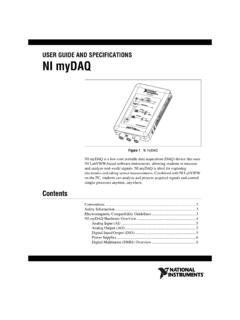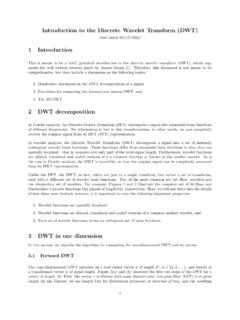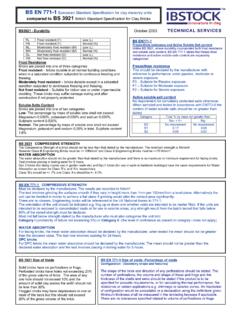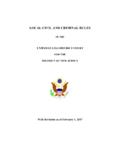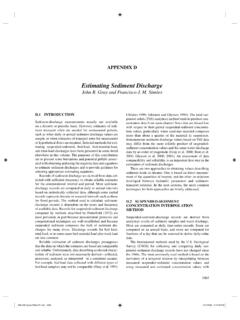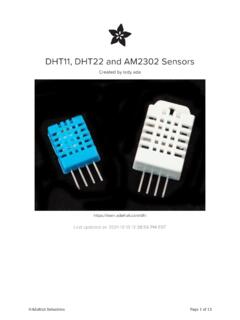Transcription of LECTURE #16: Moore & Mealy Machines
1 University of Florida Joel D. Schipper ECE Department Summer 2007 Page 1 of 8 LECTURE #16: Moore & Mealy Machines EEL 3701: Digital Logic and Computer Systems Based on LECTURE notes by Dr. Eric M. Schwartz Sequential Design Review: - A binary number can represent 2n states, where n is the number of bits. - The number of bits required is determined by the number of states. Ex. 4 states requires 2 bits (22 = 4 possible states) Ex. 19 states requires 5 bits (25 = 32 possible states) - One flip-flop is required per state bit. Steps to Design Sequential Circuits: 1) Draw a State Diagram 2) Make a Next State Truth Table (NSTT) 3) Pick Flip-Flop type 4) Add Flip-Flop inputs to NSTT using Flip-Flop excitation equation (This creates an Excitation Table.) 5) Solve equations for Flip-Flop inputs (K-maps) 6) Solve equations for Flip-Flop outputs (K-maps) 7) Implement the circuit Moore State Machines : - Outputs determined solely by the current state - Outputs are unconditional (not directly dependent on input signals) STATEOUTPUTSTATEOUTPUTINPUTINPUTINPUTINP UTGENERIC Moore STATE MACHINE Note: This should look at lot like the counter designs done previously.
2 University of Florida Joel D. Schipper ECE Department Summer 2007 Page 2 of 8 Example: Design a simple sequence detector for the sequence 011. Include three outputs that indicate how many bits have been received in the correct sequence. (For example, each output could be connected to an LED.) 1) Draw a State Diagram ( Moore ) and then assign binary State Identifiers. A000B001C011D111X=0X=0X=0X=0X=1X=1X=1X=1 Moore SEQUENCE DETECTOR FOR 011 STATESA=00B=01C=11D=10 Note: State A is the starting state for this diagram. 2) Make a Next State Truth Table (NSTT) State X O2 O1 O0 State+A 0 0 0 0 B A 1 0 0 0 A B 0 0 0 1 B B 1 0 0 1 C D 0 1 1 1 B D 1 1 1 1 A C 0 0 1 1 B C 1 0 1 1 D Q1 Q0 X O2 O1 O0 Q1+ Q0+ 0 0 0 0 0 0 0 1 0 0 1 0 0 0
3 0 0 0 1 0 0 0 1 0 1 0 1 1 0 0 1 1 1 1 0 0 1 1 1 0 1 1 0 1 1 1 1 0 0 1 1 0 0 1 1 0 1 1 1 1 0 1 1 1 0 University of Florida Joel D. Schipper ECE Department Summer 2007 Page 3 of 8 3) Pick Flip-Flop type - Pick D Flip-Flop 4) Add Flip-Flop inputs to NSTT to make an excitation table Q1 Q0 X O2 O1 O0 Q1+ Q0+ D1 D0 0 0 0 0 0 0 0 1 0 1 0 0 1 0 0 0 0 0 0 0 0 1 0 0 0 1 0 1 0 1 0 1 1 0 0 1 1 1 1 1 1 0 0 1 1 1 0 1 0 1 1 0 1 1 1 1 0 0 0 0 1
4 1 0 0 1 1 0 1 0 1 1 1 1 0 1 1 1 0 1 0 5) Solve equations for Flip-Flop inputs (K-maps) X\Q1Q0 00 01 11 10 X\Q1Q000 01 11 10 0 0 0 0 0 0 1 1 1 1 1 0 1 1 0 1 0 1 0 0 01 XQD= 010 QQXD+= 6) Solve equations for Flip-Flop outputs (K-maps) Q1\Q0 0 1 Q1\Q00 1 Q1\Q00 1 0 0 0 0 0 0 0 0 1 1 1 0 1 1 1 1 1 1 012 QQO= 11QO= 010 QQO+= Note: Moore designs do not depend on the inputs, so X can be neglected.
5 7) Implement the circuit University of Florida Joel D. Schipper ECE Department Summer 2007 Page 4 of 8 Example: Design a sequence detector that searches for a series of binary inputs to satisfy the pattern 01[0*]1, where [0*] is any number of consecutive zeroes. The output (Z) should become true every time the sequence is found. 1) Draw a State Diagram ( Moore ) and then assign binary State Identifiers. Recall: Picking state identifiers so that only one bit changes from state to state will generally help reduce the amount of hardware required for implementation. Only the transition from Success to First requires two bits to change. 2) Make a Next State Truth Table (NSTT) State Q2 Q1 Q0 X Z State+ Q2+ Q1+ Q0+ Start 0 0 0 0 0 First 0 0 1 Start 0 0 0 1 0 Start 0 0 0 First 0 0 1 0 0 First 0 0 1 First 0 0 1 1 0 Second 0 1 1 Success 0 1 0 0 1 First 0 0 1 Success 0 1 0 1 1 Start 0
6 0 0 Second 0 1 1 0 0 Delay 1 1 1 Second 0 1 1 1 0 Success 0 1 0 unused 1 0 * * X X X X X SuccessD 1 1 0 0 1 Delay 1 1 1 SuccessD 1 1 0 1 1 Success 0 1 0 Delay 1 1 1 0 0 Delay 1 1 1 Delay 1 1 1 1 0 SuccessD1 1 0 3-7) Do the remainder of the design steps.
7 University of Florida Joel D. Schipper ECE Department Summer 2007 Page 5 of 8 Mealy State Machines : - Outputs determined by the current state and the current inputs. -Outputs are conditional (directly dependent on input signals) INPUT/OUTPUTSTATESTATEINPUT/OUTPUTINPUT/ OUTPUTINPUT/OUTPUTGENERIC Mealy STATE MACHINE Example: Design a sequence detector that searches for a series of binary inputs to satisfy the pattern 01[0*]1, where [0*] is any number of consecutive zeroes. The output (Z) should become true every time the sequence is found. 1) Draw a State Diagram ( Mealy ) and then assign binary State Identifiers. University of Florida Joel D. Schipper ECE Department Summer 2007 Page 6 of 8 Moore vs. Mealy Timing Comparison Clock (CLK): Initialize 1 2 3 4 5 6 7 8 9 A B C Input (X): _ 1 0 0 1 0 0 1 0 1 1 1 0 Moore Output (Z): 0 0 0 0 0 0 0 0 1 0 1 1 0 Mealy Output (Z).
8 _ 0 0 0 0 0 0 1 0 1 1 0 0 Current State (Qi): Start Start Start First First Second Delay Delay SuccD Delay SuccD Succ Start Next State (Qi+): _ Start First First Second Delay Delay SuccD Delay SuccD Succ Start First Note: The Moore Machine lags one clock cycle behind the final input in the sequence. The Mealy Machine can change asynchronously with the input. One of the states in the previous Mealy State Diagram is unnecessary: Note: The Mealy Machine requires one less state than the Moore Machine!
9 This is possible because Mealy Machines make use of more information ( inputs) than Moore Machines when computing the output. Having less states makes for an easier design because our truth tables, K-maps, and logic equations are generally less complex. In some cases, the reduction of states is significant because it reduces the number of flip-flops required for design implementation. In spite of the advantages of using a design with less states, we will still use the 6-state Mealy Machine for the remainder of these notes to facilitate a direct comparison with the 6-state Moore Machine. University of Florida Joel D. Schipper ECE Department Summer 2007 Page 7 of 8 2) Make a Next State Truth Table (NSTT) State Q2 Q1 Q0 X Z State+ Q2+ Q1+ Q0+ Start 0 0 0 0 0 First 0 0 1 Start 0 0 0 1 0 Start 0 0 0 First 0 0 1 0 0 First 0 0 1 First 0 0 1 1 0 Second 0 1 1 Success 0 1 0 0 0 First 0 0 1 Success 0 1 0 1 0 Start 0
10 0 0 Second 0 1 1 0 0 Delay 1 1 1 Second 0 1 1 1 1 Success 0 1 0 unused 1 0 * * X

